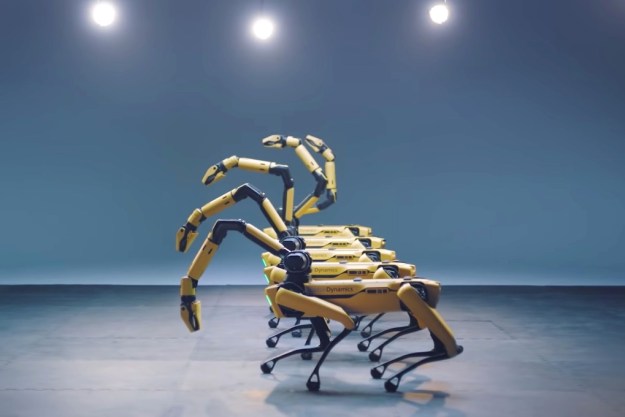Between Boston Dynamics’ assorted robo-canines and the Swiss robot dog carrying out oil rig inspections, four-legged robots are making some impressive strides these days. But, at least as far as pure strength is concerned, none can measure up to the hydraulic quadruped robot HyQReal, created by researchers at Italy’s Istituto Italiano di Tecnologia (IIT). Their robot’s feat? Nothing less than pulling a frickin’ three-ton airplane.
The Piaggio P180 Avanti airplane’s exact weight was 7,275 pounds. It was pulled a distance of more than 30 feet by a robot measuring just 2.95 feet tall and 4.3 feet long, and tipping the scale at 286 pounds. The HyQReal robot is equipped with a 48-volt battery, which powers four electric motors connected to the same number of hydraulic pumps.
“It’s a combination of strong hardware and good software,” Claudio Semini, project leader and coordinator of IIT’s Dynamic Legged Systems lab, told Digital Trends. “Moog developed a high-performance hydraulic actuation system that is used for the actuators in the legs, [and] the rubber feet are custom-made for high traction. IIT’s software can optimize the robot posture, balance, and the ground-reaction forces to increase the pulling force and the traction.”

It’s not clear exactly how much pulling-power other quadruped robots possess (consider the gauntlet thrown down). However, Boston Dynamic previously showed off a video in which 10 of its Spotmini robots worked together to pull a truck. This in itself is a pretty impressive feat, which requires a high level of coordination among the robots. Semini suggested that similar force optimization algorithms were used to achieve this feat.
Don’t expect IIT’s robots to simply be content to ferry airplanes around runways, though. “Pulling a plane was just a way to demonstrate the new robot’s strength, power autonomy, and optimized design,” Semini continued. “Planes are better moved around with wheeled vehicles. Powerful quadruped robots can be used to carry sensors and tools into hazardous areas, as well as robot arms for manipulation. We are working with the Italian Firefighters [in] a project funded by INAIL, the Italian National Institute for Insurance against Accidents. We are not targeting first response yet, but [rather] support in the aftermath of a disaster.”
Editors' Recommendations
- So THAT’S why Boston Dynamics retired its Atlas robot
- Dog-like Spot robot gets a gig to scare wildlife
- Boston Dynamics’ Spot robot to paint for an art exhibition
- Roboticist shares why she loves working at Boston Dynamics
- Watch Boston Dynamics’ Spot robot dance like the Stones’ Mick Jagger


